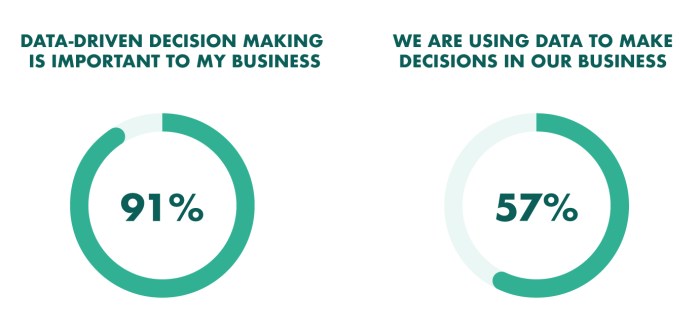Data-driven decision making is revolutionizing how businesses operate in today’s data-centric world. By leveraging data effectively, organizations can enhance their decision-making processes, leading to improved outcomes and strategic success. With the rapid growth of technology, understanding the core components of data-driven decision making has become essential for businesses looking to stay competitive.
This approach not only emphasizes the importance of data but also highlights the tools and methodologies that can transform raw numbers into actionable insights. As companies increasingly turn to data for guidance, recognizing the benefits, challenges, and future trends of this practice will empower them to make informed decisions that drive growth and innovation.
Introduction to Data-Driven Decision Making
Data-driven decision making (DDDM) is an approach that emphasizes the importance of using data to inform and guide business decisions. In today’s highly competitive landscape, organizations that leverage data effectively can gain significant advantages over their peers. DDDM allows businesses to make informed choices based on empirical evidence rather than intuition or guesswork.
Key components of DDDM include data collection, analysis, and interpretation. This systematic approach helps organizations identify trends, understand customer behavior, and enhance operational efficiency. By analyzing data, businesses can uncover insights that lead to improved outcomes, such as increased revenue, better customer satisfaction, and optimized processes.
Benefits of Data-Driven Decision Making

Utilizing data in decision-making processes offers several advantages that can propel a company to success. Not only does it help in making more accurate forecasts, but it also enables businesses to capitalize on new opportunities and mitigate risks effectively.
Examples of companies that have successfully implemented data-driven strategies include Amazon, which uses big data analytics to personalize customer experiences, and Netflix, which leverages viewer data to inform content production decisions. Statistics show that organizations that adopt data-driven practices are 5-6% more productive and profitable than their competitors.
Tools and Technologies for Data-Driven Decision Making

A variety of tools and technologies support data analysis and visualization, playing a crucial role in the DDDM process. Selecting the right data management software is vital for effective decision making, as it affects how data is processed and interpreted.
| Tool | Features | Use Cases |
|---|---|---|
| Tableau | Data visualization, dashboards, real-time analytics | Business intelligence, reporting |
| Power BI | Interactive reports, data mining, integration with Microsoft products | Enterprise analytics, performance tracking |
| Google Analytics | Web analytics, user tracking, conversion analysis | Digital marketing, website performance |
Data Collection Techniques
Collecting relevant data is a fundamental step in the DDDM process. Various methods exist for gathering data, including surveys, interviews, observations, and digital analytics. Each method offers unique advantages depending on the type of data needed and the context of the decision to be made.
Data quality and integrity are essential factors in the decision-making process. Poor quality data can lead to erroneous conclusions and misguided strategies. Best practices for collecting and handling data include:
- Define clear objectives for data collection to ensure relevance.
- Use standardized methods to minimize bias.
- Validate data from multiple sources to ensure accuracy.
- Regularly update data sets to maintain relevance.
Data Analysis Methods
Several data analysis techniques are employed to derive insights from collected data. Quantitative analysis focuses on numerical data and statistical methods, enabling organizations to analyze trends and correlations. Qualitative analysis, on the other hand, involves subjective assessment of non-numerical data such as feedback and interviews, providing context and deeper understanding.
Predictive analytics is a significant aspect of DDDM, as it uses historical data and algorithms to forecast future outcomes. This technique can be particularly useful in areas such as sales forecasting, customer behavior prediction, and risk assessment.
Case Studies on Data-Driven Decision Making

In-depth case studies illustrate how various organizations have transformed their decision-making processes through data. For instance, Target utilized data analytics to identify shopping habits, leading to personalized marketing strategies that significantly boosted sales.
Common challenges faced by these organizations often include data silos, lack of skilled personnel, and resistance to change within the company culture. However, by investing in training and adopting an agile approach to data integration, they were able to overcome these obstacles. Valuable lessons from these case studies highlight the importance of fostering a data-centric culture and continually adapting to new data insights.
Challenges in Implementing Data-Driven Decision Making
Organizations often encounter obstacles when adopting data-driven practices. Some common challenges include data privacy concerns, integration issues with existing systems, and the potential for data overload, which can lead to analysis paralysis.
Relying heavily on data for decision making also poses risks, including making decisions based solely on quantitative metrics while ignoring qualitative factors that may be crucial. Strategies to mitigate these challenges include:
- Establish clear data governance policies to protect data privacy.
- Create a cross-functional team to ensure diverse perspectives in data analysis.
- Invest in employee training to enhance data literacy across the organization.
Future Trends in Data-Driven Decision Making
Emerging trends in data analysis and decision-making technologies are set to reshape the landscape of DDDM. Artificial intelligence (AI) and machine learning (ML) are becoming increasingly integrated into data analytics, enabling more sophisticated insights and automating routine decision-making processes.
Predictions suggest that industries such as healthcare, finance, and retail will continue to leverage AI and ML to improve efficiency and customer engagement. As data sources expand and technologies evolve, the future of data-driven decision making will likely involve more real-time analytics and adaptive learning systems, further enhancing organizational agility and responsiveness.
Final Thoughts: Data-driven Decision Making
In summary, data-driven decision making stands at the forefront of modern business strategies, enabling organizations to harness the full potential of their data. Through various tools, techniques, and real-world examples, it’s clear that a well-implemented data strategy can lead to considerable advantages. As we move forward, embracing the evolving landscape of data analytics and decision-making technologies will be key to thriving in an increasingly competitive environment.
